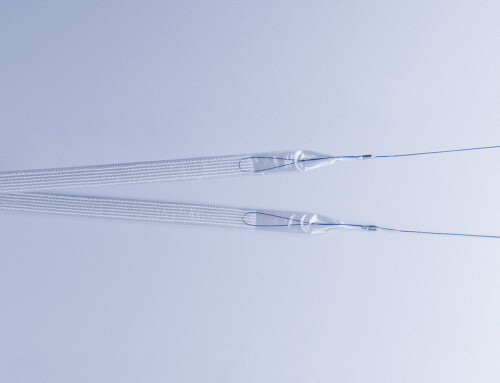Retropubic or Transobturator
A.M.I. TVA and TOA Sling
Trans Vaginal Adjustable and Trans Obturator Adjustable.
TVA and TOA slings are sling implants for support of the mid-urethra which can be adjusted post-operatively. The TVA sling can be placed by retropubic approach and the TOA sling can be placed by transobturator approach. The implants are made of a polypropylene mesh, with pull-in sutures, adjustment sutures and a detachable pull-in aid.
Indication
Surgical treatment of female SUI:
- Resulting from urethral hypermobility
- Resulting from intrinsic sphincter deficiency (ISD)
Facts
- Possibility to adjust the implant post-operatively
- Adjustment is possible in both directions. Cranial direction (tightening) in case of persisting incontinence and caudal direction (loosening) in case of over-correction
Benefits 1, 2, 3, 4, 5, 6, 7
- Possibility to adjust the implant post-operatively to improve efficacy without increased risk of complications
- Efficient improvement of incontinence in female patients with SUI
- >90% patient satisfaction during mid-term follow-up (up to 24 month) in female SUI patients
- >80% objective cure rate long-term follow-up (up to 10 years) in female SUI patients
+ Accessories
- A.M.I. TVA Tunneller
- A.M.I. TOA Tunneller
References
1 Romero-Maroto et al. (2017)
Is the adjustable TVA mesh effective for the long-term treatment of female stress incontinence?
2 Ko et al. (2012)
Proper mesh placement using the outer cylinder of a ballpoint pen in the transobturator adjustable tape sling procedure for female stress urinary incontinence
3 Patrelli et al. (2015)
Female stress urinary incontinence: Clinical efficacy and satisfaction after transobturator adjustable tape sling. An observational longitudinal cohort study
4 Romero Maroto et al. (2009)
Transobturator adjustable tape (TOA) permits to correct post-operatively the tension applied in stress incontinence surgery
5 Romero Maroto et al. (2008)
Transvaginal adjustable tape: an adjustable mesh for surgical treatment of female stress urinary incontinence
6 Zacharakis et al. (2016)
Occult Stress Urinary Incontinence in Women With Pelvic Organ Prolapse: Is the One Step Surgical Approach a Risky Choice?
7 Youn et al. (2010)
Comparison of TOA and TOT for treating female stress urinary incontinence: Short-term outcomes













